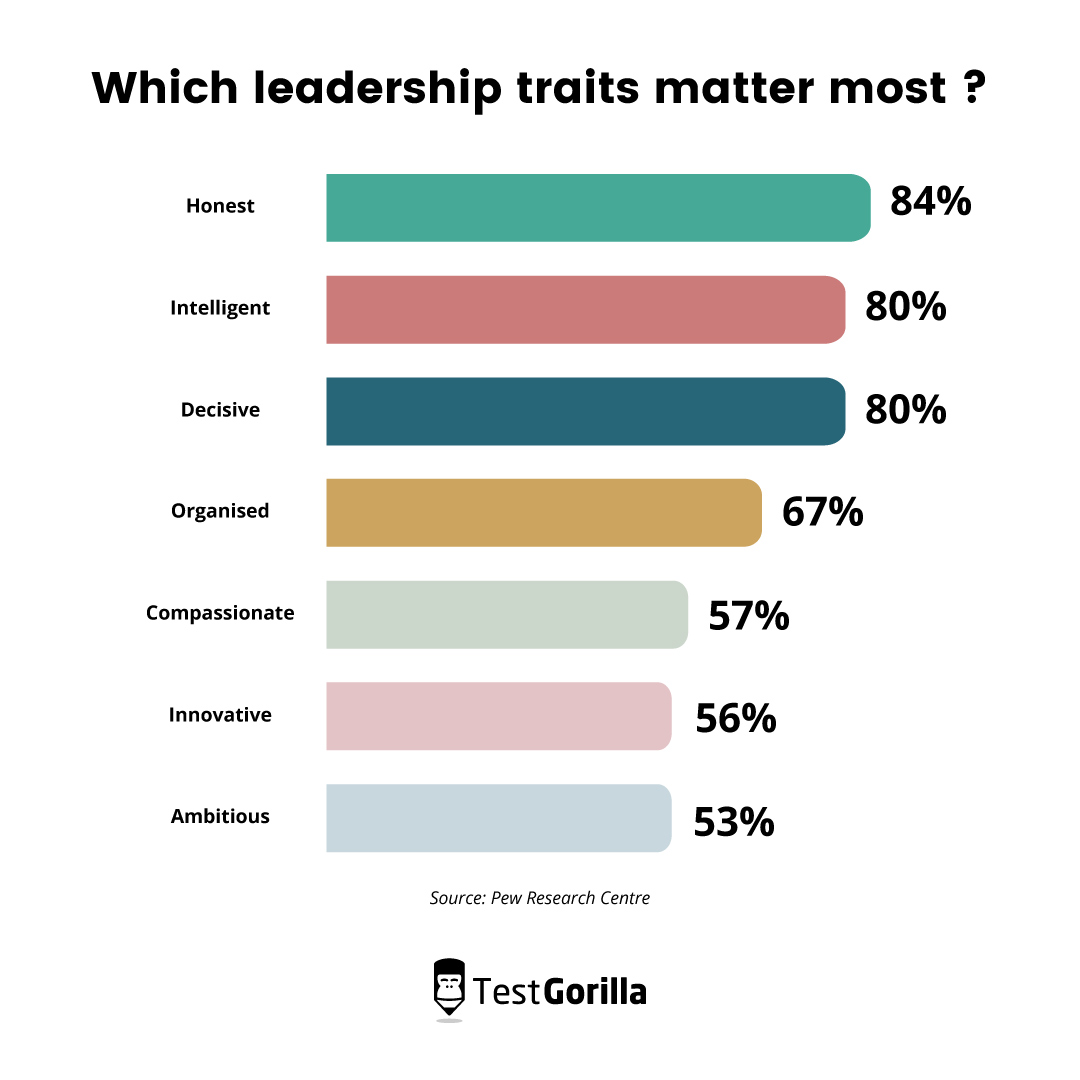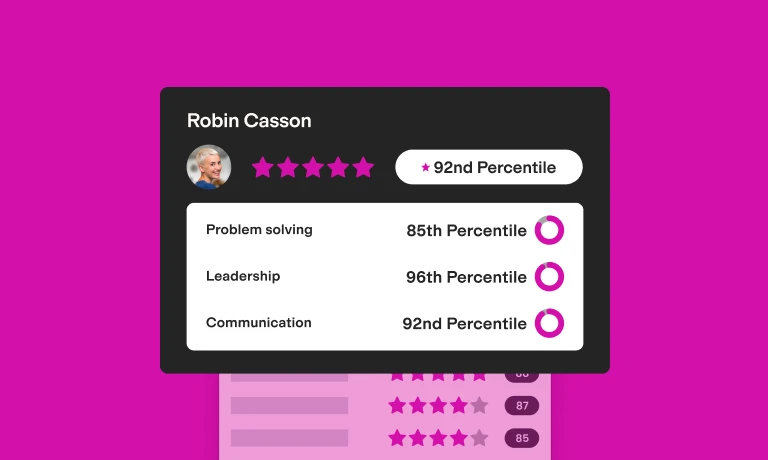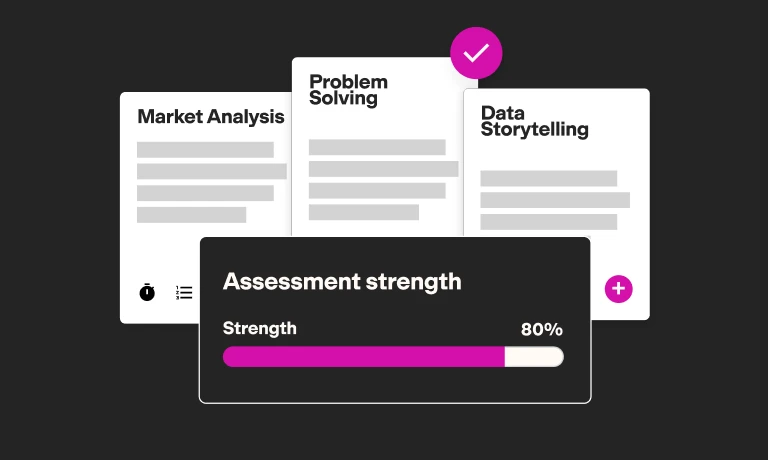Leadership development: A complete guide for HR professionals
It’s easy to assume that all managers, supervisors, and mentors are born leaders.
However, only a few of us – around 10% – have that managerial “spark” from the get-go. [1]
It’s impractical to keep hiring based on managerial experience alone. What if the leaders you do hire fail to blend with your team?
What if it turns out they’ve got the experience – but fall flat on actually motivating people?
Thankfully, there’s a fix. Why not use initiatives to tap into your own talent pool to find inspiring, enthusiastic leaders?
An effective leadership development program and management skills testing system:
Help you find potential leaders in your team
Carefully nurture and develops staff who want to succeed
Boost your ROI on talent hiring and save money on onboarding more staff
The best leaders are enthusiastic, inspiring, and always willing to support their teams. Let’s explore how to find that kind of talent in-house with leadership development strategies.
Table of contents
- What is leadership development?
- Who is leadership development training for?
- Why is leadership development important?
- Why invest in leadership development?
- What leadership skills should you focus on?
- 9 best practices for reaching your leadership development goals
- Internal leadership development: The new management hiring standard
- Sources
What is leadership development?
Leadership development prepares employees for management and other leadership roles.
It’s a series of activities, tests, and lessons that focus on the key attributes of highly effective leaders.
For example, a strong leadership training plan helps to develop:
Confidence and critical thinking
Interpersonal skills and empathy
Time and project management capabilities
However, everyone learns differently, and we all start from different points. That’s why an inclusive, multi-faceted approach to good leadership development is ideal for producing the most effective and engaging senior leaders.
Who is leadership development training for?
Leadership development benefits aspiring managers and those who are already leading teams.
It’s a common misconception that only people training to become managers seek to develop these skills, and you shouldn’t just support high-potential employees.
Employees who want to develop and progress benefit from learning specific leadership skills to help motivate others.
Existing management, meanwhile, never stops learning and developing. What’s more, only three-quarters of managers have adequate leadership training.
Even the best leaders have opportunities to learn coaching skills, feedback techniques, and ways to encourage new hires.
The business ultimately benefits in both cases because:
They save money and resources on hiring external managers
Employee retention increases
Current management gains business acumen and becomes more confident and capable of driving results
Never assume the ideal leader candidates are always the ones you hire outright.
You can create an even better management cohort from within with the right tests and principles. Keep leadership training open to those who want to stick with you.
The best insights on HR and recruitment, delivered to your inbox.
Biweekly updates. No spam. Unsubscribe any time.
Why is leadership development important?
Developing leaders in the workplace helps workers looking to advance and the companies seeking to retain them.
Let’s break this down.
Benefits of leadership development for employees
Leadership development frameworks help identify innate management potential, motivate workers who want to progress, and even drive innovation.
Leadership development doesn’t just nurture people undergoing training but the whole team.
Developing leaders learn how to better understand, motivate, and communicate with their employees.
Emerging leaders have broader access to opportunities for career development, working in different departments, and honing transferable skills for long-term benefits.
They feel more appreciated and valued, which helps build a positive company culture.
Benefits of leadership development for employers
The bottom line is you can’t always rely on finding the best managers immediately.
Just because a hire is a great manager on paper doesn’t always mean they’re effective in practice.
Beyond this, developing leadership talent from within is cost-effective and efficient and builds more satisfying professional relationships.
You’re raising leadership talent in-house based on your unique culture and working practices – meaning your teams are closer-knit, more productive, and more innovative.
Why invest in leadership development?
Let’s explore the importance of healthy leadership development and its benefits.
Benefit | Explanation |
Employees are more engaged | Leadership development helps staff gain better perspectives and become more confident and independent |
Staff retention increases | More opportunities for leadership development in-house reduce the chance of personnel quitting for promotions elsewhere |
Overall morale improves | Great leaders create positive, supportive atmospheres – and workers feel more valued |
Hiring costs decrease | There’s less need to hire from outside the company when developing from within |
You’re training the next generation | A reliable leadership development plan could roll forward and keep training future supervisors to the same standards |
Your workplace becomes more | Adaptable, proactive leaders inspire employees – they become ready to react to sudden changes and moments of urgency |
You’re better prepared for turnover | When a leader quits, you already have the framework in place to develop their replacement or to promote someone who’s already developing |
You gain a competitive edge | More collaborative, proactive companies with engaged leaders and staff are more likely to innovate and produce efficient, competitive results |
What leadership skills should you focus on?
Although there are various leadership styles, and certain ones are more effective in different workforces and situations, there are some skills all great leaders have in common.
Communication skills, interpersonal techniques, and ethical practices are among the most valuable leadership traits.
The best leader candidates promote employee engagement and are:
Supportive
Credible
Organized
Motivated
High-performing
Result-focused
And data shows us that’s not all:
Many of the most desirable leadership skills are “power skills.” Previously called “soft skills,” these traits are innately human.
Rather than requiring technical knowledge or specific expertise, power skills such as adaptability, creativity, and empathy enable leader candidates to work closely with their teams to boost morale, inspire productivity, and encourage collaborative working.
Research shows emotionally intelligent leaders are more likely to stimulate creativity in their employees.
Here are some top skills you should develop when building a leadership program in-house.
Organizational skills
A good leader is self-motivated and meticulously organized. They manage:
Timetables
Individual workloads
Available personnel
Deadlines
Project finances
Resources
Coaching plans
Organizational skills are conducive to project success, continued revenue, and customer satisfaction.
They help create great examples for team members, too.
Leaders who are well-organized, course-correct, and still stick to deadlines are inspiring. They could even inspire other team members to consider leadership development for themselves.
Delegation, too, is a crucial leadership skill. Leaders need to work closely with their staff, understand their skill sets, and balance individual workloads to avoid employee burnout.
Communication skills
Effective leaders share information and appreciate employee feedback. They understand effective team communication is a two-way street.
They need to handle the rough with the smooth, too.
They’re confident in handling good and bad feedback and managing people from all backgrounds and experiences.
Healthy feedback communication goes both ways – staff comments help leaders establish credibility and build authority.
Developing communication skills produces managers who inspire almost anyone to achieve their best. You gain leaders who respect authority and who discuss their challenges openly.
Leaders who communicate well drive better results, build stronger relationships, and boost your bottom line – helping to improve workplace communication overall.
Studies further suggest leaders with positive communicative skills engage better with their workers overall.
Problem-solving skills
A good leader knows problem-solving doesn’t just fall to their subordinates.
They’re ready to take on various challenges and explore different ways to beat them without giving up in frustration.
Your leaders are at the top of the immediate hierarchy in a busy work environment. They likely have several people working below them and depending on guidance and sign-off.
Therefore, you should always test and develop problem-solving skills to ensure leader candidates think and act on their feet.
Employees value collaborative managers – 74% of workers prefer working together to solve problems rather than leaving everything to the boss. [2]
Effective problem-solving ties in with creativity.
Creativity
A creative leader isn’t afraid to occasionally step outside their boundaries to find answers to problems.
They don’t break company rules – they’re just keen to innovate and move away from convention.
Developing creativity skills inspires people to keep trying new ideas, trusting their technical abilities and the workers they supervise.
Creativity helps leaders find pathways to reach goals within projects and employee development plans.
Agile leaders who think creatively help their staff analyze seemingly complex issues in new ways. They encourage brainstorming and sharing ideas.
Critical thinking
Critical thinking is a skill that serves all employees and leaders well. Developing a critical mindset means making decisions without bias or external influence.
A critically-thinking leader makes reasoned, practical decisions quickly and in high-pressure situations.
They don’t let opinions, emotions, or external motivations get in the way.
Critical thinking doesn’t mean removing all emotion from one’s role. It means simply dealing with the facts, the current situation, and potential outcomes.
Without critical thinking skills, managers are hard to trust with autonomy. Research suggests critical thinking is the cornerstone of complex problem-solving and appropriate communication.
Coaching
Great leaders don’t just bark orders. They work closely with staff to help them:
Achieve personal goals
Reach project checkpoints
Build healthy working mindsets
Leader coaches produce teams who are resilient, self-sufficient, happy, and ready to work.
They listen actively to individual concerns and challenges and explore support routes instead of “giving up” or punishing workers for poor results.
Employees with effective leader-coaches feel supported and valued. Instead of feeling helpless or overwhelmed, they feel capable and confident and achieve their goals.
More than 50% of staff see employee wellbeing as one of the three biggest workplace challenges. They need a coach looking out for their mental health and workload.
9 best practices for reaching your leadership development goals
Understanding why professional development, including leadership development, is so important is one thing, but how do you maintain a successful program for years to come?
Here are a few measurable ways to ensure your leadership programs are always valuable.
A recipe for a successful leadership development program
If you don’t have time to read our full guide below, here’s a quick breakdown of the best ways you can develop your leaders.
Technique | Explanation |
Assess the “status quo” | Understand your current operation and plan to keep your program simple, flexible, consistent, and accessible to all |
Keep your objectives clear | Ensure learners know what to expect, how they’re measured, and how their actions impact the wider business |
Focus on leaders | Support the development of well-rounded individuals with multiple skills and attributes – who are flexible and reliable in multiple areas |
Consider stress training | Prepare your trainee program participants for high-intensity scenarios with healthy stress management techniques – help your learners keep perspective |
Keep training varied | Offer different learning scenarios and styles to suit all needs – for example, visual, interactive, classroom, and roleplay |
Provide practice opportunities | Give trainees safe spaces to practice their skills without affecting projects |
Give feedback quickly (and thoroughly) | Adopt a 360 feedback model and help learners understand their strengths and weaknesses through unbiased, constructive reviews |
Encourage self-reflection | Help your learners become aware of their strengths, weaknesses, and challenges – and encourage them to mentor others similarly |
Build a program that represents your workforce | Build management and teams who represent your goals and ethos |
1. Assess the “status quo”
Your first step in building any leadership program should be to assess your immediate needs to build a sense of the “status quo” in your organization.
How could training help your next cohort of leaders keep a healthy, happy workforce producing exceptional work?
Feel free to identify areas of need or development.
Compare your current operation with your ideal – how far are you away from this, and what do you hypothetically need to do to ensure your workers get the adequate training they need?
Beyond this, it’s wise to build a flexible framework adaptable to multiple learning styles and the demands of your business.
Going for a generic, rigid plan prevents some people from accessing programs and developing at a pace suitable to their learning profiles.
Ensure all employees and program users access the same developmental tools, perks, and assessments.
Carefully assess what leadership looks like within your company, and decide which strengths you’d like people to develop as a priority.
2. Keep your objectives clear
Everyone benefits from clarity. Role clarity alone, for example, boosts work efficiency by up to 86%. A level starting point for all is unbiased, accessible, and keeps people motivated.
Think carefully about the impacts leaders have on your company culture.
What must you change in your current leadership approach to align it with your principles?
Show your trainees how they are measured, what you expect from them, and the support avenues they can access if needed.
Clearly show what the outcomes of specific points of development could potentially be. What effects could building empathy have on a sales leader? Could developing critical thinking boost productivity in HR?
Keeping objectives clear keeps administration simple behind the scenes. Build a leadership program that’s results-driven, measuring progress at clear checkpoints.
3. Focus on leaders
Remember, you’re developing leader mindsets, not focusing purely on individual skills. Your aim with this program is to help support well-rounded, reliable managers.
Give each key skill or competency equal importance in your training program.
Regardless of the entry-level experience of a candidate, place skills such as delegation, interpersonal skills, and organization on equal footing.
This 360-degree development model produces highly competent people with multiple skills rather than those who excel in one and struggle in several others.
Developing well-rounded leaders helps learners achieve a greater sense of accomplishment. You also open up more career opportunities within your company and greater internal mobility.
Well-rounded supervisors are easy to allocate across a talent map should you need to move or reallocate managers at short notice.
4. Consider stress training
Sometimes, leadership is highly stressful. Alongside developing power skills, ensure your learners can access stress management training and coaching support.
For example, seek to boost confidence and self-trust in your trainees. Self-awareness is encouraged for organizational success and for keeping perspective.
Training in critical thinking helps reduce the risk of emotional decisions and external influences impacting leadership.
However, even with these skills, leaders must handle stress healthily.
Encourage 1:1 coaching with trainers and peers. Offer group discussions where leadership candidates share experiences and concerns, too.
Balancing leadership development with wellbeing perks such as access to on-site leisure, mindfulness apps, and workplace events further lessens stress.
Excessive stress harms productivity, output, and mental and physical health. It’s wise to give your learners the tools to process stress rather than compact it.
To learn more about a stress-free workplace, read our blog on empathy at work.
5. Keep training varied
People all learn and develop in different ways. Using the same teaching methods and systems quickly becomes stale, boring, and unengaging.
So, keep your leadership development resources exciting and interactive.
Mix classroom setups with online modules, practice quizzes, and in-person shadowing.
Learning method preferences vary from person to person. Many prefer visual, aural, or kinesthetic learning, for example. Studies show a blend of multiple learning modes appeals to most people.[3]
Don’t bombard your trainers with pop quizzes and test after test. Use coaching and group sessions at pivotal moments in the training program, where they can share concerns and reflect on progress.
6. Provide practice opportunities
Always give leadership trainees safe spaces to practice their skills and techniques.
Ideally, safe spaces should be away from live projects, personnel, and areas where initial mistakes could cause detriment to output and self-confidence.
Consider creating roleplay scenarios and using technology to create hypothetical conditions. Roleplaying is highly effective at helping trainees retain knowledge.
Ensure trainees know they’re purely exploring right now – this won’t affect standing projects.
Provide technology such as artificial intelligence, which learners can use for roleplaying.
Practicing power skills takes time and effort, and your trainees are still developing these skills while working. Always ensure your trainees know this.
7. Give feedback quickly (and thoroughly)
As a leader yourself, always provide feedback efficiently on the back of tests, scenarios, and roleplays. Be honest and thorough about how trainees perform, too.
Be empathetic and praise progress, but be constructive and offer potential roads to recovery when trainees are struggling.
Use coaching and mentoring and encourage honesty. What problems are they facing, if any? How could you and your program support them better?
Consider using a 360-degree feedback and appraisal system to pinpoint problem areas.
It’s a system used by most companies within the Fortune 500 and helps keep assessments precise.
Through this system, individuals feed back on themselves while others (e.g., other trainees learning in collaboration) give their feedback.
This way, you expect a complete picture of how a trainee is performing based on multiple experiences. Using 360 questionnaires shows scores on a number scale rather than individual comments – however, methodologies vary.
The benefit here is trainees receive unbiased, thorough feedback that’s constructive and free from personal influence on their performance.
To learn how to avoid unconscious bias in your feedback, read our article about how to overcome unconscious bias.
8. Encourage self-reflection
With the 360-degree model discussed above, self-reflection is standard. However, providing chances for leaders to reflect on their progress throughout development is conducive to their long-term success.
Self-aware people are clear on their strengths and weaknesses.
They know how their staff and other supporters support their management styles and what they need to do to improve and assume a behavior change if needed.
They help encourage similar techniques in their staff. They make reasoned decisions, think carefully about how they impact projects, and do so without external bias.
Encourage this behavior early on to help internalize self-judgment. Remember, the key is not to produce managers who are overly critical of themselves or, conversely, overly confident and dismissive.
Instead, design a training program where prospects learn to recognize and assess strengths and weaknesses with far-reaching consequences.
9. Build a program that represents your workforce
Above all, your leadership programs should always be accessible, diverse, unbiased, and represent what your culture stands for. Take care to define your company culture, too.
Leadership represents your culture and reputation. With new hires and development, these elements continuously change.
Your leaders are the people you trust to “be your brand” on the working floor and in the public eye.
Therefore, build a leadership development system that reflects your goals, ethos, and the types of people you’d like to work with and develop.
This system helps boost your reputation as a cohesive, supportive leadership developer and encourages exceptional talent to apply for roles within your firm.
Internal leadership development: The new management hiring standard
Finding a natural-born leader isn’t easy.
Instead of sifting through hundreds of candidates who meet the job requirements and could add to your culture, focus on leadership development in-house.
For positive impact, invest in development efforts and:
Build a happier, more cohesive, collaborative culture
Keep training leaders again and again on principles that work
Encourage staff to develop and progress with you – not with the competition
Produce better quality work more frequently and drive more revenue
There are many ways to foster healthy leadership development at work – ideally, you should start with leadership tests and use them to develop reliable managers and break away from the “born leader” mindset.
Sign up for your free plan with TestGorilla, or book a free, live 30-minute demo with a member of our team to see how our software can help you streamline your hiring process.
Sources
Adkins, Amy. (April 13, 2015). “Only One in 10 People Possess the Talent to Manage”. Gallup Workplace. Retrieved May 18, 2023. https://www.gallup.com/workplace/236579/one-people-possess-talent-manage.aspx
“The Boss Barometer Report US 2019”. (n.d). Kimble. Retrieved May 23, 2023. https://www.kimbleapps.com/resources/boss-barometer-survey-us/
“VARK Research – what do we know about VARK?”. (n.d). VARK: A Guide to Learning Preferences. Retrieved May 20, 2023. https://vark-learn.com/research-statistics/
You've scrolled this far
Why not try TestGorilla for free, and see what happens when you put skills first.



















